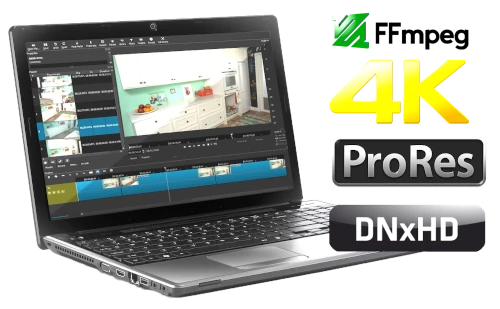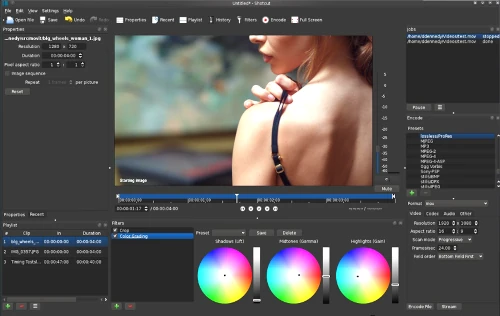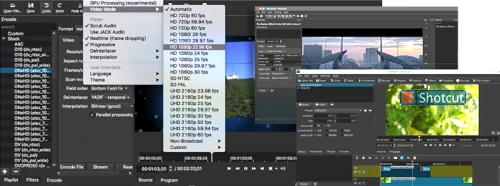Shotcut: The Free and Open-Source Video Editor That Leaves Paid Solutions in the Dust

Don’t have the budget for Adobe Premiere or Final Cut?
You shot a video with your phone, a camcorder, or a drone… and now you’re wondering how you’re going to edit it. Of course, you want a good result. Maybe even professional quality. But here’s the catch: pro-grade editing software is ridiculously overpriced.
Let’s be honest: those price tags are outrageous and often hard to justify. And for small, one-off amateur projects, they’re just not worth it. So maybe you’re thinking about “magic” AI editing? Sure, it sounds tempting. But if you actually want full control and the exact result you have in mind, that’s a bad call.
The good news is, just like with many other digital tools, there’s a free and open-source alternative that gets the job done beautifully… and can hold its own against those sky-high commercial options.
Why Choose Open-Source Software for Video Editing?
Using an open-source video editor means you’ll never get locked into a subscription that ends up costing more than your camera gear. No sneaky trackers watching what you do, no terms of service changing overnight. And best of all, you’ll never wake up to find you’ve lost access to your files or project settings because some company decided to shut down its servers or block older versions.
With open-source software, you stay in full control of your tools, your files, and your creative future. Install it on as many machines as you want, tweak it to fit your workflow, and work with open formats. It’s a zero-cost investment that pays off in nothing but benefits. Hard to argue with that.
Quick Overview of Shotcut
Shotcut is like the Swiss Army knife of free, open-source video editing. Launched in 2011, it’s built by a passionate community and powered by the rock-solid technical foundation of FFmpeg and the MLT framework. The result? It can read and export virtually any audio or video format without worrying about proprietary limitations.

Major perks: it’s available on Linux, macOS, and Windows. Its lightweight open-source setup doesn’t require you to buy overpriced hardware to run it. The modular, customizable interface adapts to your workflow. You can show or hide panels, create multiple timelines, and even set up custom shortcuts.
And best of all… no registration, no mandatory cloud, no subscription. You just download it, install it, and start editing. Period.
Free Codecs: Keep Full Control of Your Videos
Shotcut supports a wide range of free codecs thanks to the power of FFmpeg. AV1, VP9, Theora, FFV1, Opus, Vorbis, FLAC… The advantage? These are open formats, free from patents or proprietary licensing.
In practical terms, that means long-term accessibility, because your files will remain readable over time. It also means interoperability, since these formats work just about anywhere, with no technical lock-ins and zero royalties to pay.
All of this forms the foundation of an excellent video editor that stays true to the open-source spirit. From capture to final delivery, you’re in control. And if your project requires compatibility with certain platforms or hardware, Shotcut can also export to proprietary formats. That choice is always yours to make.
Shotcut’s Superpowers
Shotcut can easily stand toe-to-toe with the giants of video editing. You can play and edit your files directly from the timeline, without wasting time on lengthy imports or conversions. Thanks to FFmpeg, it handles just about every format. From a quick clip shot on your phone to 8K HDR footage, Shotcut has you covered.
On the video side, it packs a full set of advanced tools: transitions, filters, color correction, slow motion, time-lapse, reverse playback, chroma key for compositing, precise keyframe control. And if you want to push things further, Glaxnimate integration lets you create or import vector animations and custom graphic effects.

On the audio side, you get a real mixing environment: equalizer, compressor, filters, normalization, and full multichannel audio support. For workflow comfort, there’s GPU-accelerated rendering, batch export, support for Blackmagic professional cards, and live capture from a camera, webcam, or even a network stream.

But if you’re new to editing and just want to throw a video together quickly, don’t let all those technical terms scare you off. Shotcut is still very beginner-friendly. It only takes a few minutes to learn the basics and start doing exactly what you want, without getting lost in menus or buried in complicated settings.
Tip for 100% Free and Open Editing with Shotcut
If you want to stay true to Shotcut’s open-source spirit, the best approach is to adopt a fully free workflow from start to finish.
- At the shooting stage: whenever possible, set your camera to record in an open format (or at least one that’s easy to convert to a free codec).
- During editing: work directly with these formats in Shotcut, without being forced to convert to a proprietary format.
- At export: choose AV1 or VP9 for the web, and FFV1 for high-quality archiving.
- For publishing: use a free platform like PeerTube instead of a locked-down service like YouTube, which compresses your videos and treats your privacy as a product to sell.
The result: you keep total control over your content and contribute to a truly independent video ecosystem.
NovaFuture’s Best Tips for Getting 100% Out of Shotcut
At NovaFuture, we love Shotcut and we use it! Not a lot right now, since we’re not producing many videos. That could change pretty soon, as we’re seriously considering launching our own PeerTube instance. We’ll talk more about that when the time comes 😉.
And to really get the most out of Shotcut, here’s the obvious truth: Linux is where it shines! We use Linux Mint daily and love it, but other distros like Ubuntu or Arch Linux work just as well.
No matter your operating system, the main problem with all video editors is the same: rendering times are long, especially in 4K on a desktop PC! But with Linux, you can easily set up a small network of machines to process the workload in a cluster.
The result? Drastically reduced encoding times. And it works for 3D rendering too, if you’re working with something like Blender. In our case, we run our cluster on two Raspberry Pis. No screens, keyboards, or mice needed. Everything is handled from the console. In the end, it’s simple and incredibly cheap on the hardware side.
Sure, it might sound a little technical at first. But if, like us, you can’t afford a high-end workstation, it gets the job done perfectly. And if you want to give it a try, or if you’ve got tips of your own, drop by our forum dedicated to free and open-source software. We love talking about this stuff!
Conclusion
Shotcut is simply amazing! A huge thank-you to its entire team of developers who have been improving this gem of free video editing for years.
And if you ever need a hand using it, here’s some good news: they’ve got an old-school forum, the kind we love, that’s very active and quick to respond. Whether you’re a beginner or an advanced user, you’ll quickly find answers to all your questions there.
Did you enjoy this topic? Want us to talk more often about powerful, accessible free software? Then treat us to a coffee ☕ on Buy Me a Coffee. It’s our fuel to keep testing, writing, and sharing free alternatives that really make a difference. Thanks for sharing!